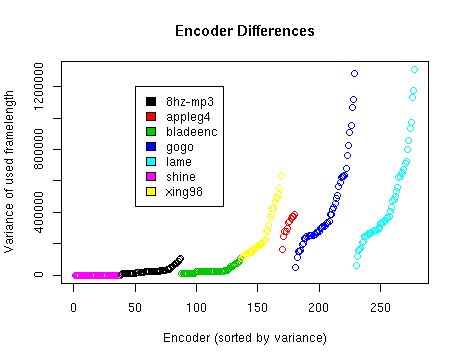
Example for Encoder DifferencesFrom a high-level point of view, MP3 files consist of a series of frames. For example, a constant bitrate (CBR) MP3 stream uses 38 frames to store one second of 44.1 kHz audio data. As all frames size equally, a reservoir mechanism enables the share of data between adjacent frames. Therefore the effective amount of data processed per frame may vary depending on the extent of the use of the reservoir. This variation produces dissimilarities between MP3 files of different encoders: For example, the very basic Shine encoder doesn't use the reservoir at all. |

|
|
The above plot depicts theses dissimilarities. From a set of test files encoded with different encoders and bitrates (112, 128, and 192 kHz) we calculated the variance of the effective frame lengths (measured in bits) over the whole MP3 stream. One point in the plot represents one MP3 file. Obviously - and coherent with our prior knowledge - Shine produces no variance at all. While the variance of 8hz-Mp3 and BladeEnc files rests in a relativley narrow range, Lame and Gogo lead to a wide spread of variance of frame lengths. |